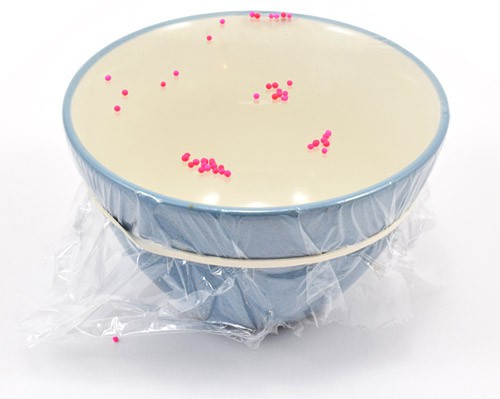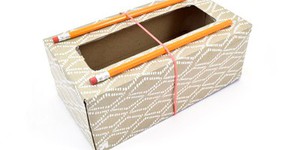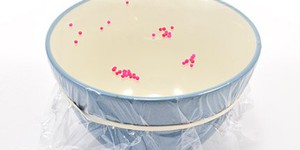Summary
Introduction
You might know that sound is caused by vibrations, but did you know that sound can also make things vibrate? You might have noticed this if you have ever been at a concert or in a car with the stereo booming. Sometimes the sounds are so loud that you can feel the vibrations! However, sounds that loud can damage your hearing, so in this project you will investigate them using something safer.
Materials
- Cup or bowl
- Rubber band that fits around the cup or bowl
- Plastic wrap
- Colored sprinkles (you can also use salt, but the sprinkles are easier to see)
- Large plate or tray
 Image Credit: Ben Finio, Science Buddies / Science Buddies
Image Credit: Ben Finio, Science Buddies / Science Buddies
Prep Work
- Stretch a piece of plastic wrap across the top of the bowl.
- Use a rubber band to hold the plastic wrap in place.
- Adjust the plastic wrap so it is tight and as flat as possible with no wrinkles.
- Put the bowl onto a plate or tray to catch any sprinkles that fall off.
 Image Credit: Ben Finio, Science Buddies / Science Buddies
Image Credit: Ben Finio, Science Buddies / Science Buddies
Instructions
- Bring your lips very close to the edge of the bowl without touching it.
- Try humming loudly, and watch the plastic wrap closely.What happens? Can you see anything?
- Add some sprinkles to the top of the plastic wrap.
- Try humming again. Watch the sprinkles closely.
- If nothing happens, try humming louder
- If nothing happens, try varying the pitch of your humming (higher or lower).
- If the sprinkles fall off the bowl, add more of them as needed.What happens when you stop humming?
What Happened?
Did you make the sprinkles dance? When you hummed loudly enough and at the right pitch, the sound waves generated by your voice should have made the plastic wrap membrane vibrate. The vibrations of the clear plastic wrap are hard to see on their own. When you add sprinkles, the vibrating membrane makes them bounce up and down, so the vibrations are much easier to see. For a more detailed explanation of the physics behind this project, see the Digging Deeper section.
Digging Deeper
Have you ever heard the age-old riddle "if a tree falls in a forest, and there is no one there to hear it, does it make a noise?" If you know how sound waves work, then the answer is pretty simple. Sound waves are created by vibrating objects that bump into adjacent air molecules. These air molecules bump into other nearby air molecules, and so on, transmitting the vibration through the air to our ears. Sometimes these vibrations are easy to see (e.g. when you pluck a rubber band), but most times the vibrations are too small or too fast for us to see (e.g. when you knock on a door, it makes a sound, even though you cannot see the door vibrate). In the case of the falling tree, the tree will still cause vibrations when it hits the ground, even if there is no one there to hear it.
So if vibrations cause sounds, can sounds also cause vibrations? It turns out that it works both ways, and this is what allows us to hear. You have probably heard of your eardrums, tiny membranes inside your ears (maybe an adult told you not to poke anything tiny or sharp into your ears, because you could damage them). When vibrating air molecules hit the membrane, they cause it to vibrate. These vibrations are converted into electrical signals that are sent to your brain.
In this activity, you made a membrane that behaved similarly to your eardrum. Depending on the size, shape, and material of the container you used, you might have had to adjust the pitch of your humming to get the sprinkles to dance. If your pitch was too high or too low, the sprinkles might not have moved at all. If you got the pitch just right, the sprinkles might have bounced around like crazy and even fallen off the bowl. The way an object responds to sounds of different pitch is called its frequency response. Frequency is measured in hertz (Hz), or the number of sound waves per second. Human hearing typically has a range from around 20 Hz to 20,000 Hz, meaning frequencies in that range will cause your ear drum to vibrate. Some animals, like dogs, can hear much higher frequencies, up to around 45,000 Hz. That means that unlike humans, their ear drums are sensitive to vibrations at higher frequencies. That is why dogs can hear "dog whistles" but we cannot!
Ask an Expert
For Further Exploration
- Try the activity with different-sized granular materials. For example, what happens if you use tiny spherical sprinkles vs. bigger oblong sprinkles or "jimmies"? What about salt or grains of rice?
- Try the activity with containers in different sizes, shapes, and materials.
- Try putting the bowl in front of a speaker and playing music.
- Search for a "tone generator" app or website on your phone, and try playing a constant tone near the bowl. Some tones can hurt your ears, so start with the volume very low and increase it gradually.
Related Resources
Lesson Plans
- 1-PS4-1. Plan and conduct investigations to provide evidence that vibrating materials can make sound and that sound can make materials vibrate.
- 1-PS4-1. Plan and conduct investigations to provide evidence that vibrating materials can make sound and that sound can make materials vibrate.











